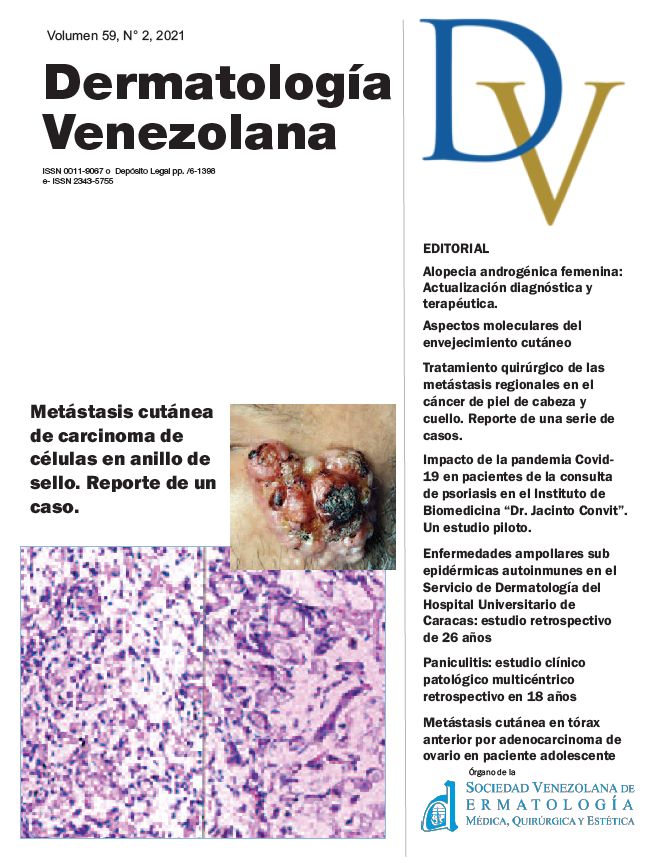Aspectos moleculares del envejecimiento cutáneo.
Palabras clave:
ADN, ARN, biomarcadores, envejecimiento, molecular, pielResumen
El envejecimiento de la piel es la manifestación más visible y evidente del envejecimiento del organismo y puede servir como predictor de la esperanza de vida y salud. Sin embargo, también el deseo humano de belleza a lo largo de toda la vida aumenta aún más el interés en el tema. Por ende en los últimos años se han puesto considerables medios y esfuerzos en investigación básica y aplicada para estudiar los mecanismos del envejecimiento de la piel. Estos trabajos han ayudado a profundizar nuestra comprensión sobre la complejidad biológica y molecular de los procesos fisiológicos que ocurren en la piel. Los cambios producidos por el envejecimiento cutáneo afectan a cada uno de los componentes o capas de la piel, desde el estrato córneo hasta el tejido celular subcutáneo y se reflejan en las características clínicas del envejecimiento. En este contexto a nivel molecular se han descrito alteraciones como una menor capacidad para reparar daños del ADN, desgaste de los telómeros y alteraciones en los mecanismos de señalización celular que modifican la funcionalidad de genes involucrados en la producción de enzimas que degradan componentes moleculares de la piel, así como en el comportamiento de moléculas comprometidas en procesos de inflamación, conducentes a las alteraciones celulares e histológicas que ocurren durante el envejecimiento cutáneo. En esta revisión se describen algunas de ellas.
Referencias
Referencias
Russell-Goldman E, Murphy GF. The Pathobiology of Skin Aging: New Insights into an Old Dilemma. American Journal of Pathology 2020; 190:1356–69.
Naylor EC, Watson REB, Sherratt MJ. Molecular aspects of skin ageing. Maturitas 2011; 69:249–56.
Hadshiew IM, Eller MS, Gilchrest BA. Skin aging and photoaging: The role of DNA damage and repair. American Journal of Contact Dermatitis 2000; 11:19–25.
Hoeijmakers JHJ. Genome maintenance mechanisms for preventing cancer. Nature 2001; 411:366–74.
Moriwaki S, Takahashi Y. Photoaging and DNA repair. Journal of Dermatological Science 2008; 50:169–76.
Chouinard N, Therrien JP, Mitchell DL, Robert M, Drouin R, Rouabhia M. Repeated exposures of human skin equivalent to low doses of ultraviolet-B radiation lead to changes in cellular functions and accumulation of cyclobutane pyrimidine dimers. Biochem Cell Biol 2001;79(4):507–15.
Goukassian D, Gad F, Yaar M, Eller MS, Nehal US, Gilchrest BA. Mechanisms and implications of the age‐associated decrease in DNA repair capacity. FASEB J 2000; 14(10):1325–34.
Ko LJ, Prives C. p53: Puzzle and paradigm. Genes and Development 1996; 10:1054–72.
Levine AJ. p53, the cellular gatekeeper for growth and division. Cell 1997; 88:323–31.
Li G, Ho VC. p53-Dependent DNA repair and apoptosis respond differently to high- and low-dose ultraviolet radiation. Br J Dermatol 1998; 139(1):3–10.
Tron VA, Trotter MJ, Ishikawa T, Ho VC, Li G. p53-dependent regulation of nucleotide excision repair in murine epidermis in vivo. J Cutan Med Surg 1998;3(1):16–20.
Al Rashid ST, Dellaire G, Cuddihy A, Jalali F, Vaid M, Coackley C, et al. Evidence for the Direct Binding of Phosphorylated p53 to Sites of DNA Breaks In vivo. Cancer Res 2005; 65(23):10810–21.
Tanaka H, Arakawa H, Yamaguchi T, Shiraishi K, Fukuda S, Matsui K, et al. A ribonucleotide reductase gene involved in a p53-dependent cell-cycle checkpoint for DNA damage. Nature 2000; 404(6773):42–9.
Talbert PB, Henikoff S. Histone variants on the move: Substrates for chromatin dynamics. Nature Reviews Molecular Cell Biology. 2017; 18:115–26.
Contrepois K, Coudereau C, BB-N. Histone variant H2A.J accumulates in senescent cells and promotes inflammatory gene expression. Nat Commun. 2017; 10;8:14995.
Mangelinck A, Coudereau C, Courbeyrette R, Ourarhni K, Hamiche A, Redon C, et al. The H2A.J histone variant contributes to Interferon-Stimulated Gene expression in senescence by its weak interaction with H1 and the derepression of repeated DNA sequences. bioRxiv 2020 2020.
Isermann A, Mann C, Rübe CE. Histone variant H2A.J marks persistent DNA damage and triggers the secretory phenotype in radiation-induced senescence. Int J Mol Sci 2020; 21(23):1–20.
Rübe CE, Bäumert C, Schuler N, Isermann A, Schmal Z, Glanemann M, et al. Human skin aging is associated with increased expression of the histone variant H2A.J in the epidermis. npj Aging Mech Dis 2021]; 7(1):1–11.
Blackburn EH, Epel ES, Lin J. Human telomere biology: A contributory and interactive factor in aging, disease risks, and protection. Science 2015; 350(6265):1193–8.
Sugimoto M, Yamashita R. Telomere length of the skin in association with chronological aging and photoaging. Journal of dermatological science 2006; 43(1):43-47.
Kruk PA, Rampino NJ, Bohr VA. DNA damage and repair in telomeres: relation to aging. Proc Natl Acad Sci 1995; 92(1):258–62.
Zhan Y, Hägg S. Association between genetically predicted telomere length and facial skin aging in the UK Biobank: a Mendelian randomization study. GeroScience 2021; 43(3):1519–25.
Siegl-Cachedenier I, Flores I, Klatt P, Blasco MA. Telomerase reverses epidermal hair follicle stem cell defects and loss of long-term survival associated with critically short telomeres. J Cell Biol 2007; 179(2):277–90.
Ramunas J, Yakubov E, Brady JJ, Corbel SY, Holbrook C, Brandt M, et al. Transient delivery of modified mRNA encoding TERT rapidly extends telomeres in human cells. FASEB J 2015; 29(5):1930–9.
Jacczak B, Rubiś B. Potential of Naturally Derived Compounds in Telomerase and Telomere Modulation in Skin Senescence and Aging. International Journal of Molecular Sciences 2021; 22(12):6381.
Petersen S, Saretzki G, Von Zglinicki T. Preferential Accumulation of Single-Stranded Regions in Telomeres of Human Fibroblasts. Exp Cell Res 1998; 239(1):152–60.
Jogi R, Tager M. Bovine Colostrum, Telomeres, and Skin Aging. Journal of Drugs in Dermatology: JDD 2021; 20(5):538-545.
Dupré-Crochet S, Erard M, Nüβe O. ROS production in phagocytes: why, when, and where? J Leukoc Biol 2013; 94(4):657–70.
Rittié L, Fisher GJ. UV-light-induced signal cascades and skin aging. Ageing Res Rev 2002; 1(4):705–20.
Ichihashi M, Ueda M, Budiyanto A, Bito T, Oka M, Fukunaga M, et al. UV-induced skin damage. Toxicology 2003; 189(1–2):21–39.
Noh EM, Park J, Song HR, Kim JM, Lee M, Song HK, et al. Skin aging-dependent activation of the PI3K signaling pathway via downregulation of PTEN increases intracellular ROS in human dermal fibroblasts. Oxid Med Cell Longev 2016;2016.
Schagen SK, Zampeli VA, Makrantonaki E, Zouboulis CC. Discovering the link between nutrition and skin aging. Dermato-Endocrinology 2012; 4:298–307.
Volpe CMO, Villar-Delfino PH, Dos Anjos PMF, Nogueira-Machado JA. Cellular death, reactive oxygen species (ROS) and diabetic complications review-Article. Cell Death Dis 2018; 9(2).
Zhang S, Duan E. Fighting against Skin Aging: The Way from Bench to Bedside. Cell Transplantation 2018; 27:729–38.
Wang Y, Wang L, Wen X, Hao D, Zhang N, He G, et al. NF-κB signaling in skin aging. Mechanisms of Ageing and Development. 2019; 184.
Quan T, Shao Y, He T, Voorhees JJ, Fisher GJ. Reduced expression of connective tissue growth factor (CTGF/CCN2) mediates collagen loss in chronologically aged human skin. J Invest Dermatol 2010; 130(2):415–24.
Quan T, Fisher GJ. Role of age-associated alterations of the dermal extracellular matrix microenvironment in human skin aging: A mini-review. Gerontology 2015; 61:427–34.
Verrecchia F, Chu ML, Mauviel A. Identification of Novel TGF-β/Smad Gene Targets in Dermal Fibroblasts using a Combined cDNA Microarray/Promoter Transactivation Approach. J Biol Chem 2001; 276(20):17058–62.
Gao W, Wang Y shuai, Hwang E, Lin P, Bae J, Seo SA, et al. Rubus idaeus L. (red raspberry) blocks UVB-induced MMP production and promotes type I procollagen synthesis via inhibition of MAPK/AP-1, NF-κβ and stimulation of TGF-β/Smad, Nrf2 in normal human dermal fibroblasts. J Photochem Photobiol B Biol 2018; 185:241–53.
Zhang M, Hwang E, Lin P, Gao W. Prunella vulgaris L. Exerts a Protective Effect Against Extrinsic Aging Through NF-κB, MAPKs, AP-1, and TGF-β/Smad Signaling Pathways in UVB-Aged Normal. Rejuvenation Research 2018; 21(4):313-322.
Ansary TM, Hossain MR, Kamiya K, Komine M, Ohtsuki M. Inflammatory Molecules Associated with Ultraviolet Radiation-Mediated Skin Aging. Int J Mol Sci 2021; 22:3974.
Hui H, Zhai Y, Ao L, Jr JCC, Liu H, Fullerton DA, et al. Klotho suppresses the inflammatory responses and ameliorates cardiac dysfunction in aging endotoxemic mice. Oncotarget 2017; 8(9):15663–76.
Zhang B, Xu J, Quan Z, Qian M, Liu W, Zheng W, et al. Klotho Protein Protects Human Keratinocytes from UVB-Induced Damage Possibly by Reducing Expression and Nuclear Translocation of NF-κB. Med Sci Monit. 2018; 24:8583–91.
Blander G, Bhimavarapu A, Mammone T, Maes D, Elliston K, Reich C, et al. SIRT1 promotes differentiation of normal human keratinocytes. J Invest Dermatol 2009; 129(1):41–9.
Xu F, Xu J, Xiong X, Deng Y. Salidroside inhibits MAPK, NF-κB, and STAT3 pathways in psoriasis-associated oxidative stress via SIRT1 activation. Redox Rep 2019; 24(1):70–4.
Song IB, Gu H, Han HJ, Lee NY, Cha JY, Son YK, et al. Omega-7 inhibits inflammation and promotes collagen synthesis through SIRT1 activation. Appl Biol Chem 2018; 61(4):433–9.
Shen T, Duan C, Chen B, Li M, Ruan Y, Xu D, et al. Tremella fuciformis polysaccharide suppresses hydrogen peroxide-triggered injury of human skin fibroblasts via upregulation of SIRT1. Mol Med Rep 2017; 16(2):1340–6.
Chien Y, Scuoppo C, Wang X, Fang X, Balgley B, Bolden JE, et al. Control of the senescence-associated secretory phenotype by NF-κB promotes senescence and enhances chemosensitivity. Genes Dev 2011; 25(20):2125–36.
Wlaschek M, Maity P, Makrantonaki E, Scharffetter-Kochanek K. Connective Tissue and Fibroblast Senescence in Skin Aging. J Invest Dermatol 2021; 141(4):985–92.
da Silva PFL, Ogrodnik M, Kucheryavenko O, Glibert J, Miwa S, Cameron K, et al. The bystander effect contributes to the accumulation of senescent cells in vivo. Aging Cell 2019; 18(1).
Kammeyer A, Luiten RM. Oxidation events and skin aging. Ageing Research Reviews 2015; 21:16–29.
Ou HL, Schumacher B. DNA damage responses and p53 in the aging process. Blood 2018; 131:488–95.
Gannon HS, Donehower LA, Lyle S, Jones SN. Mdm2-p53 signaling regulates epidermal stem cell senescence and premature aging phenotypes in mouse skin. Dev Biol 2011; 353(1):1–9.
Bai GL, Wang P, Huang X, Wang ZY, Cao D, Liu C, et al. Rapamycin Protects Skin Fibroblasts From UVA-Induced Photoaging by Inhibition of p53 and Phosphorylated HSP27. Front Cell Dev Biol 2021; 9.
Mancini M, Lena AM, Saintigny G, Mahé C, Di Daniele N, Melino G, et al. MicroRNAs in human skin ageing. Ageing Research Reviews. 2014; 17:9–15.
Terlecki-Zaniewicz L, Pils V, Bobbili MR, Lämmermann I, Perrotta I, Grillenberger T, et al. Extracellular Vesicles in Human Skin: Cross-Talk from Senescent Fibroblasts to Keratinocytes by miRNAs. J Invest Dermatol 2019; 139(12):2425-2436.e5.
Tan J, Hu L, Yang X, Zhang X, Wei C, Lu Q, et al. miRNA expression profiling uncovers a role of miR-302b-3p in regulating skin fibroblasts senescence. J Cell Biochem 2020; 121(1):70–80.
Röck K, Tigges J, Sass S, Schütze A, Florea AM, Fender AC, et al. miR-23a-3p Causes Cellular Senescence by Targeting Hyaluronan Synthase 2: Possible Implication for Skin Aging. J Invest Dermatol 2015; 135(2):369–77.
Muther C, Jobeili L, Garion M, Heraud S, Thepot A, Damour O, et al. An expression screen for aged-dependent microRNAs identifies miR-30a as a key regulator of aging features in human epidermis. Aging 2017; 9(11):2376–96.
Kim YJ, Lee SB, Lee HB. Oleic acid enhances keratinocytes differentiation via the upregulation of miR-203 in human epidermal keratinocytes. J Cosmet Dermatol 2019; 18(1):383–9.
Borgia F, Custurone P, Peterle L, Pioggia G, Guarneri F, Gangemi S. Involvement of micrornas as a response to phototherapy and photodynamic therapy: A literature review. Antioxidants 2021: 10.
Ruiz GP, Camara H, Fazolini NPB, Mori MA. Extracellular miRNAs in redox signaling: Health, disease and potential therapies. Free Radical Biology and Medicine. 2021; 173:170–87.
Yang C, Luo L, Bai X, Shen K, Liu K, Wang J, et al. Highly-expressed micoRNA-21 in adipose derived stem cell exosomes can enhance the migration and proliferation of the HaCaT cells by increasing the MMP-9 expression through the PI3K/AKT pathway. Arch Biochem Biophys 2020; 681.
Descargas
Publicado
Número
Sección
Licencia
Publicado por la Sociedad Venezolana de Dermatología Médica, Quirúrgica y Estética







